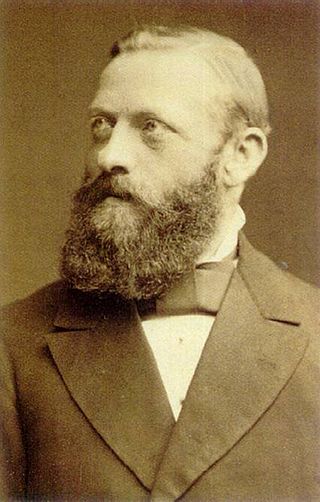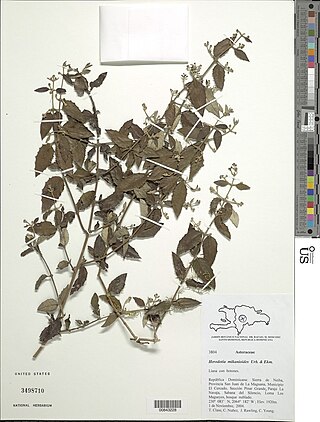
Senecio is a genus of flowering plants in the daisy family (Asteraceae) that includes ragworts and groundsels.

Zanthoxylum is a genus of about 250 species of deciduous and evergreen trees, shrubs and climbers in the family Rutaceae that are native to warm temperate and subtropical areas worldwide. It is the type genus of the tribe Zanthoxyleae in the subfamily Rutoideae. Several of the species have yellow heartwood, to which their generic name alludes. Several species are cultivated for their use as spices, notably including Sichuan pepper.

Myrica is a genus of about 35–50 species of small trees and shrubs in the family Myricaceae, order Fagales. The genus has a wide distribution, including Africa, Asia, Europe, North America and South America, and missing only from Australia. Some botanists split the genus into two genera on the basis of the catkin and fruit structure, restricting Myrica to a few species, and treating the others in Morella.

Acidoton is a genus of plant of the family Euphorbiaceae first described as a genus in 1788. It is native to the Greater Antilles, Central America, and tropical South America.

Erik Leonard Ekman was a Swedish botanist and explorer.
Dussia is a genus of flowering plants in the family Fabaceae. It includes 11 species native to the tropical Americas, ranging from central Mexico to Bolivia and west-central Brazil.

Amyris is a genus of flowering plants in the citrus family, Rutaceae. The generic name is derived from the Greek word αμυρων, which means "intensely scented" and refers to the strong odor of the resin. Members of the genus are commonly known as torchwoods because of their highly flammable wood.

Banara is a genus of flowering plants in the family Salicaceae.

Ignatz Urban was a German botanist. He is known for his contributions to the flora of the Caribbean and Brazil, and for his work as curator of the Berlin Botanical Garden. Born the son of a brewer, Urban showed an interest in botany as an undergraduate. He pursued further study at the University of Bonn and later at the University of Berlin where he gained a doctorate in 1873. Urban was appointed by A. W. Eichler to run the Berlin Botanical Garden and supervised its move to Dahlem. He also worked as Eichler's assistant on the Flora Brasiliensis, later succeeding him as editor. In 1884 Urban began working with Leopold Krug on his Puerto Rican collections, a collaboration would later produce the nine-volume Symbolae Antillanae, one of his most important contributions, and his 30-part Sertum Antillanum. Urban's herbarium, estimated to include 80,000 or more sheets, was destroyed when the Berlin Herbarium was bombed in 1943, during the Second World War.

Rondeletia is a genus of flowering plants in the family Rubiaceae. It is endemic to the Neotropics. There are around 160 species.

Heterosavia is a genus of the family of Phyllanthaceae first described as a genus in 2008. It is native to the Caribbean and southern Florida. It is found in Bahamas, Cayman Islands, Cuba, Dominican Republic, Florida, Haiti, Jamaica, southwest Caribbean and Turks-Caicos Islands.
Nesampelos is a genus of flowering plants in the daisy family, native to the Island of Hispaniola in the West Indies.

Ekmaniopappus is a genus of flowering plants in the daisy family.

Guilandina is a genus of flowering plants in the legume family, Fabaceae. It belongs to the subfamily Caesalpinioideae and tribe Caesalpinieae.
Colleteria is a genus of flowering plants in the family Rubiaceae, native to Cuba, Hispaniola, and Puerto Rico. Among other differences from the genus Chione, from which they were split, they have fruit with two pyrenes.
Torralbasia is a monotypic genus of flowering plants belonging to the family Celastraceae. It only contains the one known species, Torralbasia cuneifolia(C.Wright ex A.Gray) Krug & Urb.
Neobuchia is a monotypic genus of flowering plants belonging to the family Malvaceae. It only contains one known species, Neobuchia paulinae, commonly known as mapou blanc. It is a tree endemic to Haiti on the island of Hispaniola.
Stevensia is a genus of flowering plants belonging to the family Rubiaceae.
Samuelssonia is a monotypic genus of flowering plants belonging to the family Acanthaceae. It has only one known species, Samuelssonia verrucosa, a small tree which grows to 5 meters tall which is native to the Massif de la Hotte in Haiti.
Isidroa is a monotypic genus of flowering plants belonging to the family Verbenaceae. The only species is Isidroa spinifera.












